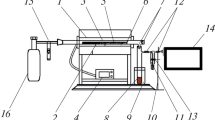Abstract
Coal samples containing 6.9% volatile matter (anthracite) have been investigated by use of a TG-DTA-MS technique. Estimation of the ash content, volatile matter (d.a.f.) and moisture is possible during one experiment. On running under ASTM conditions, separate tests have to be carried out. When the thermoanalytical curves were recorded in air, a particle diameter of 0.063 mm was most advantageous, because the heating of coal samples with a larger particle size at a heating rate of 10 deg/min−1 caused explosion of the particles and the TG-DTA data was not reproducible. The mass fragments of the volatile products range fromm/z=16 tom/z=300 at a working pressure of approximately 10−6 mbar in the mass spectrometer.
Zusammenfassung
Kohleproben mit einem Gehalt an flüchtigen Bestandteilen von 6.9% w.a.f. wurden mit Hilfe simultaner Thermogravimetrie-Differenzthermoanalyse-Massenspektroskopie untersucht. Diese Untersuchungsmethode gestattet die Bestimmung des Aschegehaltes, der flüchtigen Bestandteile und der Feuchtigkeit in einem Experiment. Um diese Daten entsprechend der ASTM- (ISO)Bedingungen zu ermitteln, müssen separate Tests durchgeführt werden. Zur Ermittlung der DTA-Daten in Luft unter Normaldruck haben sich Proben mit einem Korndurchmesser von 0.063 mm als vorteilhaft erwiesen. Da durch Anwendung höherer Heizraten als 10 K min/s-1 größere Teilchen explosionsartig zersetzt werden, sind die TG-DTA-Daten nicht mehr reproduzierbar. Die Massenbruchstücke der flüchtigen Bestandteile erstreckt sich vonm/z=16 bism/z=300 bei einem Druck von 10−6 mbar im Massenspektrometer.
Резюме
Совмещенным методом ТГ-ДТА-МС были исследованы образцы углей, содержащих 6,9% летучего вещества. О пределение зольност и, летучего вещества и в лаги проводится одним экспериментом. При снятии термоаналитических кривых в атмосфере воздуха, частица с диа метром 0,063 мм была наибо лее благоприатной, поско льку нагревание со скоростью 10° в минут у частиц угля с больши м размером приводило к взрыву и ТГ-ДТА-данные не были воспроизводимы. Масс овые числа летучих продуктов на ходились в области м/з=16–300 при раб очем давлении в масс-спектрометре ра вным приблизительно 10−6 мбар.
Similar content being viewed by others
References
C. Karr, Jr., Analytical Methods for Coal and Coal Products, I, II, Academic Press, New York, 1978.
Round Table, Chemical and Physical Valorization of Coal, Bruxelles, 23., 25. Nov. 1980, EUR 7633 DE-EN-FR-II.
K.-H. Ohrbach, G. Radhoff and A. Kettrup, Fres. Z. Anal. Chem., 314 (1983) 398.
K.-H. Ohrbach, G. Radhoff and A. Kettrup, Intern. J. of Mass Spectr. and Ion Phys., 47 (1983) 59.
A. Kettrup, 7th International Conference on Thermal Analysis, Kingston, Canada, 26. 08. 1982.
K.-H. Ohrbach, G. Radhoff and A. Kettrup, Thermochim. Acta, 67 (1983) 189.
K.-H. Ohrbach, G. Radhoff and A. Kettrup, Thermochim. Acta, 67 (1983) 197.
K.-H. Ohrbach, G. Radhoff and A. Kettrup, Thermochim. Acta, 72 (1984) 165.
H. L. C. Meuzelaar et al., Characterization of Rocky Mountains, Coals and Coal Liquids by Computerized Analytical Techniques, University of Utah, DOE-DE-FG 22-80PC30242.
Author information
Authors and Affiliations
Rights and permissions
About this article
Cite this article
Ohrbach, K.H., Klusmeier, W. & Kettrup, A. TG-DTA-MS Investigations of coal, and characterization of the volatile products released as a function of temperature. Journal of Thermal Analysis 29, 147–152 (1984). https://doi.org/10.1007/BF02069950
Received:
Issue Date:
DOI: https://doi.org/10.1007/BF02069950



